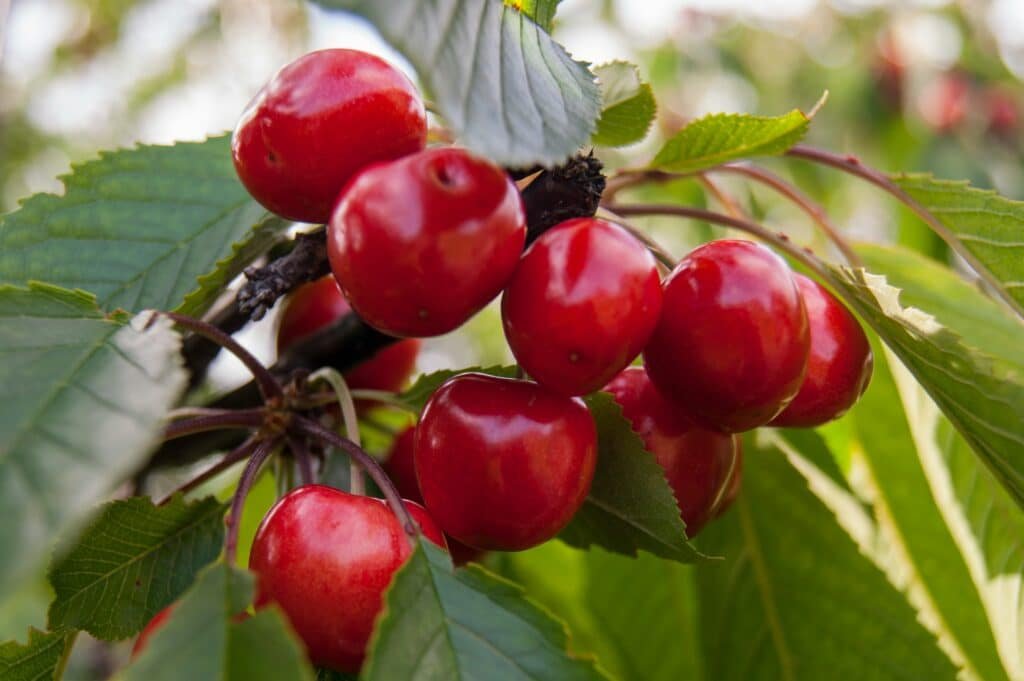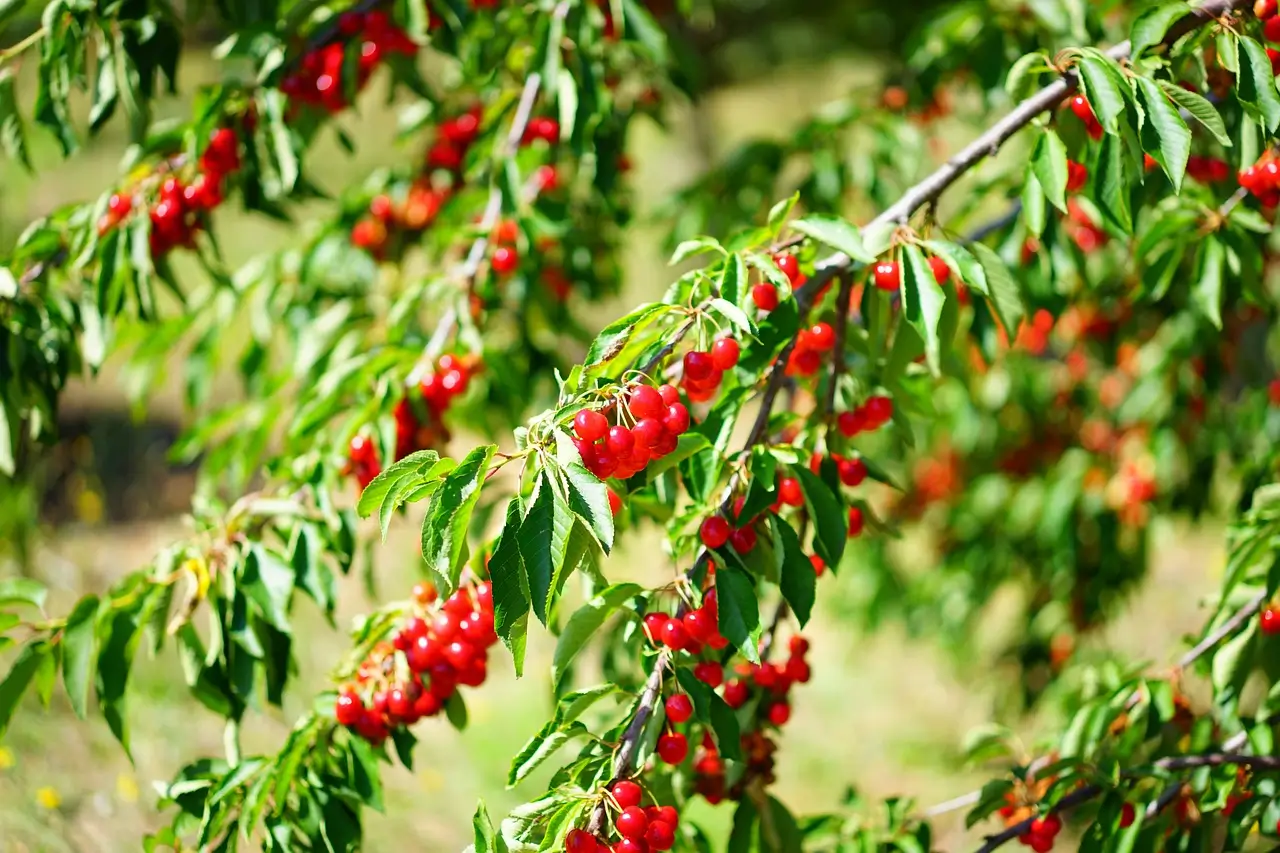Cherry blossoms are iconic symbols of spring. Their beautiful pink and white flowers can transform trees into stunning multidimensional works of natural art. And let’s not forget about the tasty fruit that cherry trees produce once the flowers fade!
But when it comes to growing cherry trees in your own landscape, you may be wondering:
Are cherry trees actually fast growing trees compared to other species?
It’s a great question if you’re eager to enjoy these aesthetic and edible landscape specimens sooner rather than later. Let’s take a deeper look at cherry tree growth rates and see how they compare.
What Type of Cherry Tree Are We Talking About?
There are over 1,000 cultivars of cherry tree across North America, each with varying mature sizes, uses, and growth rates. Here are some of the main types:
- Cherry Plum: Small, round-headed tree that grows 15-25 ft tall.
- Black Cherry: Native cherry tree growing 50-60 ft tall. Known for lustrous, reddish-brown bark.
- Pin Cherry: Small native cherry tree growing 20-30 ft tall. Short-lived but fast growth makes it ideal for land restoration projects.
- Sweet Cherry: Fruited eating cherry growing 15-25 ft tall. Requires chill hours to set fruit.
- Sour Cherry: Fruited cooking cherry for pies and jams, reaching 15-18 ft tall. Higher chill hours than sweet cherries.
- Weeping Cherry: Grafted ornamental cherry with cascading branches. Growth rate depends on rootstock.
So when evaluating whether cherry trees are fast growing or not – the answer can vary quite a bit depending on exactly which type you choose.
How Fast Do Cherry Trees Grow?
On average, a newly planted cherry tree can grow 12-24 inches per year once established. But again – the expected growth rate can vary based on the cultivar.
Here’s a quick growth timeline for two popular types:
Sweet Cherry Growth Rate
- Years 1-2: Focus is on root establishment with 1-2 ft of growth per year.
- Years 3-7: Enters prime fruiting years, growing 2+ ft per year.
- Year 10+: Reaching mature size of 15-25 ft tall and wide. Slows growth rate.
Weeping Cherry Growth Rate
- Years 1-2: Establishes roots, grows 1-2 ft per year. Requires staking.
- Years 3-5: Grows 2-3 ft per year. Starts weeping form.
- Year 10+: Approaches mature cascading form near 10 ft tall x 15 ft wide.
No matter what the cultivar, several key factors affect cherry tree growth rate:
- Type of Cherry Tree: Dwarf trees grow slower than full-size trees. Sour cherries are smaller than sweets.
- Climate and Location: Cool climates limit growth compared to warmer areas.
- Soil Conditions: Cherry trees like nutrient-rich, well-draining soil. Poor soil stunts growth.
- Pruning and Care: Proper fertilization, watering, and pruning encourage steady development.
So with ideal soil, climate, and care – some cherry tree types can put on 2-3 ft of growth per year during their prime.
Comparison of Growth Rates: Cherry Trees vs. Other Tree Species
Cherry trees are considered moderately fast growing deciduous trees. But how does their yearly growth stack up against other landscape tree species?
Extremely Fast Growing Trees
A few tree species tower above cherry trees when it comes to extremely rapid growth:
- Cottonwood (Populus deltoides) – Grows 6+ ft per year! Up to 80 ft tall.
- Empress Tree (Paulownia tomentosa) – Gains up to 5 ft per year maturing at 40-60 ft tall.
- Silver Maple (Acer saccharinum) – Grows 3-6 ft yearly when young, reaching 50-80 ft.
So while cherry trees grow faster than many broadleaf trees, they simply can’t keep pace with the fastest-growing tree giants.
Moderately Fast Growing Trees
When comparing annual growth rates with other moderately fast growing trees, cherries do stack up more favorably:
- Autumn Blaze Maple – Grows 2-3 ft yearly when young, reaching 40-60 ft tall.
- Trident Maple – Average growth of about 2 ft per year. Matures around 30 ft tall and wide.
- Redbud – Grows 1-2 ft annually when young, slowing when it reaches 20-30 ft tall.
So you can see cherries fall nicely within this moderately fast growing category, trading blows with maples and sometimes surpassing redbuds.
Takeaway on Growth Rate Comparisons
- Extremely Fast? No – Cherries don’t match cottonwoods and paulownias.
- Moderately Fast? Yes – Similar yearly growth as maples and faster than redbuds.
- Faster than Most Fruit Trees – Cherries outpace apples, stone fruits, citrus.
So while not off-the-charts fast growing, cherries do establish rather quickly compared to other fruiting orchard options.
Advantages of Cherry Trees for Landscaping

Given their ornamental flowers, edible fruit, vibrant fall color and moderately quick growth – what’s not to love about cherry trees? Here are some key benefits:
Aesthetic Beauty
- Flowers: Few flowering trees can match the sheer elegance of the spring cherry blossom display.
- Fruit: Both edible fruits and ornamental berries provide seasonal interest.
- Fall Color: Leaves transition to yellow, gold, and red hues before dropping.
Quick Establishment
- Maturing in 5-10 years depending on type, cherry trees provide fulfilment faster than slow growing oaks or beeches.
- Their relatively rapid juvenile growth allows you to reap visual and edible benefits sooner.
Less Pruning & Maintenance
- Compared to extremely fast growing trees like willows or poplars, cherry trees are less aggressive and require less frequent pruning.
- Their moderate growth results in stronger wood and form than very fast growing trees.
So in many ways, the growth rate of cherry trees strikes an ideal balance – moderating speed with aesthetics and lower maintenance needs.
Best Uses in Landscaping and Key Planting Tips
When working cherry trees into the home landscape, keep these planting guidelines and uses in mind:
Ideal Garden Spots
- Full Sun: Cherry trees need a minimum of 6 hours direct sun per day during the growing season. This fuels growth.
- Well-drained Soil: Standing water promotes root rot. Pick a slope or amend soil to improve drainage.
- Shelter from Winds: Protect young saplings from strong winds which can hamper growth.
Spacing for Growth
- Allow ample space between trees:
- Standard Cherry: 20-25 ft apart
- Dwarf Cherry: 10-15 ft apart
- Adjust spacing to grow single specimen or multi-trunk grove.
Encouraging Growth
- Weed Control: Reduce competition from grass and weeds.
- Fertilization: Apply balanced fertilizer in early spring.
- Prune Judiciously: Avoid heavy pruning that diverts energy from growth.
- Water in Droughts: Supply extra water during dry periods for steady expansion.
Ideal Uses
- Specimen Focal Point: Feature a single ornamental cherry as a landscape centerpiece.
- Fruiting Orchard: Grow multiple cherry trees in orchard or edible landscape.
- Property Line: Use columnar cherry cultivars for narrow privacy screening.
By following these best practices for siting, spacing, care and uses – you’ll set your cherry trees up for success!
The Verdict: Yes and No on Rapid Growth
Cherry trees are considered moderately fast growing deciduous trees – but are they “fast growing” in the absolute sense? As with most things in life, the answer depends on perspective:
- Compared to extremely rapid growing trees like cottonwood – no, cherries would not be considered fast growing.
- Relative to slow growing oak and beech trees – yes, cherries do establish quicker.
- For a fruiting orchard tree, cherry growth rates are faster than most other orchard options.
The bottom line? Cherry tree growth speed lies in the eye of the beholder. Their yearly expansion of 2+ feet suits most landscaping timelines. With the right cultivar choice and TLC, you’ll be enjoying blossoms or juicy cherries within a 5-10 year range. For most homeowners, that constitutes a fast growing tree indeed!
